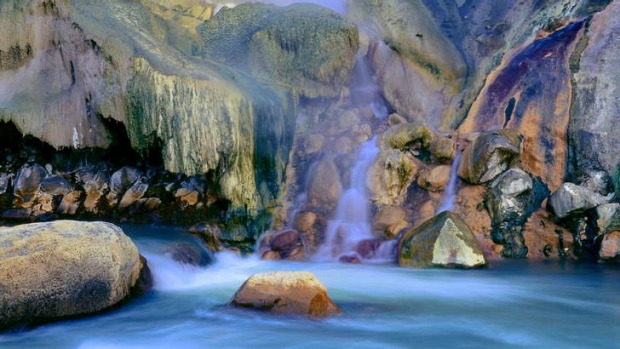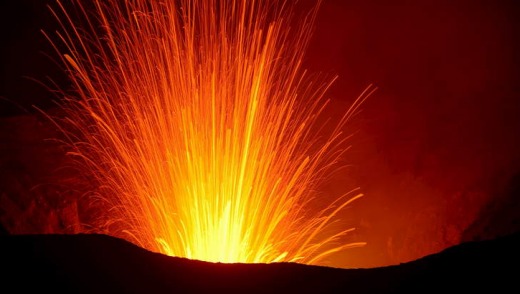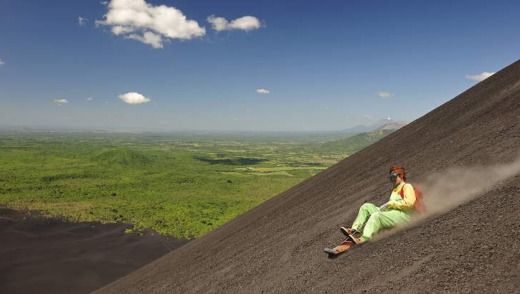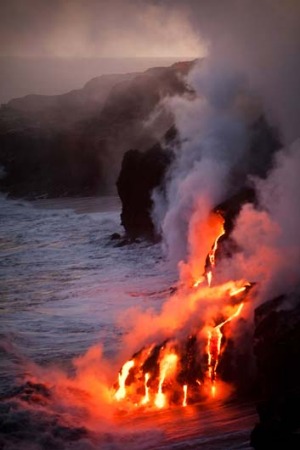
Louise Southerden lives dangerously on a series of tours for vulcanologists and other lovers of lava.
From the ash-burial of the Roman city of Pompeii by Vesuvius in AD79 to the Icelandic and Chilean ash clouds that affected millions of air travellers in 2010 and 2011, volcanoes have been toying with us for centuries. Their indisputable, sheer power is what makes them so compelling. How thrilling it is to get close to a volcano, peer into its maw, and survive.
Volcano tourism, as it's now called, is the greatest show on Earth and the big top is not far away: there are about 600 active volcanoes in the world and 50 to 70 erupt each year. There are also more ways to experience volcanoes safely. Here are a few options:

Soviet airspace: Kamchatka
There can be few experiences more exhilarating than flying around volcanic peaks in an ex-Soviet Mi8 helicopter in Kamchatka, in the Russian Far East, an area closed to outsiders until the 1990s. As day trips go, this is one of the most scenically splendid in one of the most volcanically volatile places in the world. Kamchatka has more than 300 volcanoes, 29 of them active. You'll take off in a field near the main city of Petropavlovsk-Kamchatskiy, fly over several active volcanoes and their crater lakes, and make three stops: in Uzon caldera, a 12-kilometre-wide crater filled with boiling lakes and mud pots and frequented by Kamchatka brown bears (all tourist groups are accompanied by an armed ranger); the Valley of the Geysers, a narrow gorge filled with steaming, spouting geysers; and beside the Zhupanova River, where you can bathe in a thermal hot spring before having a picnic.
Fast facts Valley of the Geysers helicopter tours run June-October and cost $US990 ($850) a person. See heritage-expeditions.com (based in New Zealand).

Rumble in the jungle: Vanuatu
Only in a place such as Vanuatu could you four-wheel-drive almost to the edge of one of the world's most accessible, and least regulated, active volcanoes, and watch molten rocks shoot out of its belly to land at your feet, at night. (Guides even nonchalantly light their cigarettes from the red-hot rocks.) Yasur, called "the lighthouse of the Pacific" for its regular eruptions, is on the island of Tanna, south of Port Vila, and an hour's rugged drive from the coast, past villages and coffee plantations. From the parking area, it's a short walk in fading light to the crater rim, guided by an orange glow emanating from the volcano's interior. Standing on the edge, not a safety rail or warning sign in sight, you'll hear a low, primeval rumble. Stay as long as you dare, then use the torches provided by your guide to find your way back to the vehicle (hard hats are also available).
Fast facts White Grass Ocean Resort arranges Yasur Volcano Safaris for its guests, for 9900 vatu ($100). Rooms start at 26,000 vatu a night. See whitegrassvanuatu.com.vu.

3. Volcano in the sea:
New Zealand
The 80-minute boat ride to White Island, 50 kilometres off the east coast of the North Island, begins benignly. Most days you'll see dolphins, whales and fur seals en route to New Zealand's only marine volcano. Getting closer, you'll see it's a small volcano-island: just two kilometres across and 320 metres high. Before disembarking, however, you're issued with a hard hat and a gas mask to protect against toxic gases that emanate from the volcano's steaming fumaroles. An inflatable boat takes you ashore, where you set off, on foot, into a live volcano. Your only escape, should White Island erupt, is that boat. All of which adds to the dramatic setting - clouds of scalding steam, hissing fissures, acidic pools, the ruins of an old sulphur mining operation that ended in 1914 when a lahar (a debris-mudslide) killed 10 workers. Early Maori visitors called White Island "the dramatic volcano" (Te Puia o Whakaari) when they came to hunt grey-faced petrels, which they cooked over volcanic vents. Now the only inhabitants of this privately owned nature reserve are the 3000 Australasian gannets that nest in the yellow and white volcanic cliffs.
Fast facts White Island Tours runs all-day boat tours to White island from Whakatane (in the Bay of Plenty) for $NZ199 ($158) a person. See whiteisland.co.nz.
4. Megapodes and egg-men: PNG
The volcano that buried Rabaul, one of the gems of the Pacific, in 1994 now offers an unusual volcanic experience. Take a boat from Kokopo, the "new Rabaul", in PNG's East New Britain province, to the base of Tuvurvur, where you'll find a black-sand beach and a row of dugout outrigger canoes. Walk towards the sand cliffs and, out of the grey gloom, men appear, caked in volcanic ash, like statues come to life. It's akin to walking into the pages of National Geographic. The men are here for the eggs of megapodes, chicken-like birds that bury their eggs to incubate them in the warm volcanic ash. The birds are protected but the eggs are free for the taking - if you call hard labour "free". If you're lucky, you'll see a successful haul: one man standing in a sandy hole deeper than he is tall, passing up to a dozen large eggs to a mate sitting on the rim, while other ash-covered men lean on their shovels to watch. The eggs sell for about 2 kina (90¢) each at Kokopo's market, but you can buy them here, too, fresh from the earth; just ask your resort staff to cook them for your breakfast next morning.
Fast facts Kokopo Beach Bungalow Resort runs harbour cruise tours for 650 kina to the Vulcan and Tavurvur volcanoes, where you can go ashore to see the egg-men. Bungalows start at 520 kina a night. See kbb.com.pg.
5. Bikes and lava-boats: Hawaii
Mark Twain described sunrise from the top of Haleakala, on the Hawaiian island of Maui, as "the sublimest spectacle I ever witnessed". What's even better is seeing the sunrise from the top of this 3028-metre volcano, peering into its enormous crater - it's almost a kilometre deep and big enough to contain Manhattan - then mountain biking down the outside. The 60-kilometre ride is a free-wheel descent down a winding, two-lane road through scenic Haleakala National Park, past pineapple plantations and tropical rainforests, the temperature rising as you lose altitude. For the complete "summit to sea" experience, finish the morning with a dip in the ocean. Hawaii is also one of the few places in the world you can see lava flowing into the ocean, on a sunrise cruise along the south-eastern coastline of Hawaii (the Big Island). The preamble alone is worth the price of admission - Volcanoes National Park, lava sea cliffs and arches, black-sand beaches shaded by jungle. But the main event is sublimely spectacular: red rivers of lava meet the Pacific in explosions of steam, plume clouds and underwater upwellings.
Fast facts Haleakala Bike Company runs Sunrise Tours in Maui from $US101.99 (for online bookings). See bikemaui.com. Lava Ocean Adventures's Lava Boat Tours depart at 5am, 7.30am, 2pm and 4.30pm, and cost $US150-$US175, dependent on time of day. See seelava.com.
6. Hot water and ice: Antarctica
For an icy volcano encounter, try Deception Island in the South Shetlands, north-west of the Antarctic Peninsula. You can cruise right into its flooded horseshoe-shaped caldera, the 10-kilometre-wide Port Foster, which was created when the volcano blew its top 10,000 years ago, ejecting 30 cubic kilometres of magma into the surrounding sea. Because the volcano is still active, the sand at the shoreline can be warm, even hot, particularly at low tide. At Pendulum Cove, where the water is warmest, you can strip to your swimmers and sit in the shallows for a hot spring "wallow" surrounded by steaming black-sand beaches, blackened glaciers and lots of penguins; the island has the largest colony of chinstraps, more than 600,000 breeding pairs. Deception Island's most recent eruptions were 20 years ago but it's officially "restless", which adds to the excitement of bathing in hot pools on a remote Antarctic island accessible only by sea.
Fast facts All Aurora Expeditions's Antarctic Peninsula trips stop at Deception Island. A nine-day sail/fly expedition (cruising from Ushuaia to Antarctica, returning by air to Punta Arenas in Chile) starts at $US6875 for a triple share cabin. See auroraexpeditions.com.au.
7. Now showing: eruptions
One of the growing trends in volcano tourism is "eruption tours" - tours to active volcanoes at short notice, subject to volcanic activity and safety. The unpronounceable Icelandic volcano, Eyjafjallajokull, was crawling with tourists wanting to see it in all its pyrotechnic splendour in 2010, but there are operators that monitor volcanic activity around the world and specialise in trips at short notice to volatile places. One of them is VolcanoDiscovery, whose tours are led by vulcanologists. It also runs regular trips to the Democratic Republic of the Congo, where two highly active volcanoes in Virunga National Park rarely disappoint.
Fast facts VolcanoDiscovery, see volcanodiscovery.com. Volcano Tours, in Iceland, runs luxury jeep day tours of Eyjafjallajokull for 28,900 krona ($210), see volcanotours.is.
8. Volcano surfing: Nicaragua
In 2004, Nicaragua claimed a world first in volcano tourism: it pioneered "volcano-boarding" on the slopes of an active volcano, in this case the 726-metre Cerro Negro (black mountain), one of the most active of Nicaragua's 19 volcanoes. No experience is necessary and orange overalls, protective goggles, and purpose-built "volcano boards" made of metal and reinforced plywood are provided - you can "surf" the board standing up and holding on to the handle attached to the front, or sitting on it toboggan-style. Either way, what goes down must first go up. Tours start with a 40-minute drive from Leon, the second-largest city in Nicaragua, and an hour-long hike up the back of the volcano (not the side you slide down) to the top of Cerro Negro. After enjoying the expansive views of Cerro Negro's seven sister volcanoes, you'll receive a lesson in the art of volcano-boarding. Then you'll have a five-metre practice run (inside the crater) before hurtling 500 metres down the steep black-ash sides of the volcano at speeds of up to 90km/h (which gets you to the bottom in less than four minutes).
Fast facts Big Foot Hostel and Volcano Boarding has volcano boarding tours for $US28 a person. See bigfootnicaragua.com.